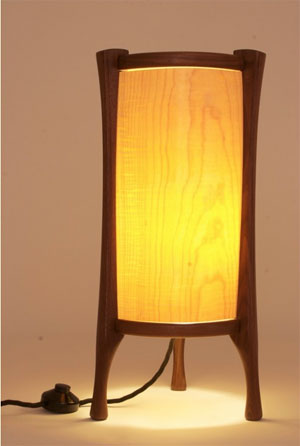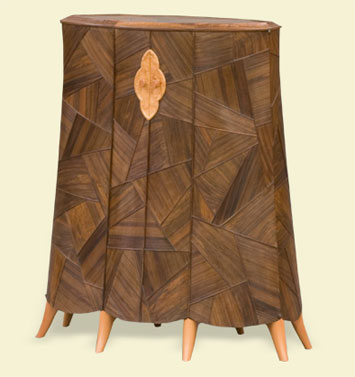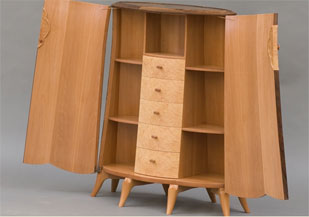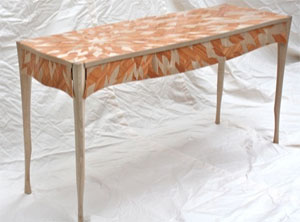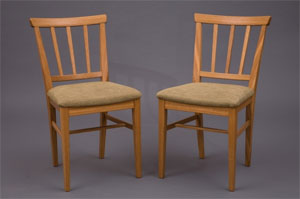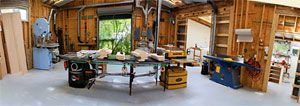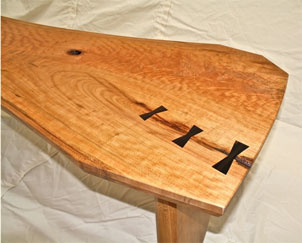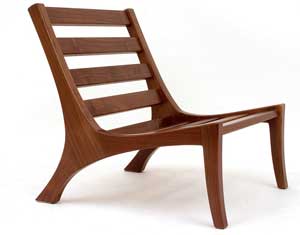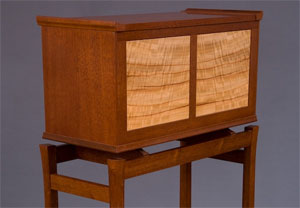
When he bought his first house “in complete disrepair,” all Jason Strawowned for tools “was a socket and a screwdriver.” As he continued buying rundown houses, Jason moved up to “a one-car garage, with a router and a table saw.” As he dealt with the wood floors and the “old-school carpentry” in these historic houses, however, he started wanting to “not work so hard all weekend.”
A natural progression from his carpentry, he thought, was to build “a picnic table or something.” Jason hied himself off to the library, where he found project-specific woodworking books — that he thought were “extremely boring.” Then he ran across one of James Krenov’s books. “He talks about woodworking, but makes it romantic and poetic,” Jason said.
With few woodworkers in his area, and a lack of apprenticeship opportunities from those who were, Jason decided he needed a formal education in woodworking. While staying with a friend in Denver during the economic recession (“when the economy took a dive, I figured working on houses was going to dry up for a while), Jason worked for Newell Design Studiofor a time.
“At that point, I found out James Krenov had a school in California.” After his first application to the College of the Redwoods, “I didn’t get in initially, but luckily, somebody dropped out, and they called me — probably because I called them every week to ask if somebody dropped out. I was the first one at school every morning, and usually the last one to leave at night, for nine months.”
During the summer break from the program, Jason took a course in boat building, and he was one of five students selected to return for the program’s second year. He finished many projects during his time of schooling, because, he said, “I felt like I needed to build my body of work.”
Jason also spent some time studying with Brian Newell, who taught him complex furniture: “I learned how to do compound curves, compound bends; he got me started in carving, and weird marquetry, and exotics, like all the rosewoods.”
Jason’s piece Incunabula is one that he describes as “a Brian Newell knockoff” — and “my departure from Krenov aesthetics, with a lot of straight lines.” In that piece, “I used pretty much every trick of the trade: bent laminations, veneer, carving, marquetry and inlay, compound pieces…it’s where I learned I could pretty much do anything with wood.
“It was a no-holds-barred situation to make that piece,” he said. The lack of a particular tool or machine, “wasn’t going to stop me from doing something. With hand hand tools, jigs, rasps…like Sam Maloof said, he would use his teeth if necessary. I really had to use my teeth on it.”
Although Jason was speaking figuratively about his teeth in this case, he notes that different options don’t always occur to people. “People think the challenge is ‘how to get a machine to do “this,” when really, the challenge is how to get your hands to do “this.” Sometimes, you just sharpen a chisel and go for a while.”
When he grabs a chisel and goes for a while, Jason might be carving out arms on a chair, or a decorative motif. Overall, “the techniques of a decorative nature are the things that I’m drawn to — any technique that brings out the art.”
Jason is clear, in fact, that “I want my piece to be art, foremost. Some people will spend $1,000 on a painting that took two days, but they won’t spend that on a chair that took a week, because they don’t see it as art. I’m trying not to have that argument; I’m trying to show that my work is art. But unless a piece of furniture is decorated, people will often overlook it, like it’s a piece of factory furniture.”
In fact, every few months, Jason’s shop in Gainesville, Florida, is part of the downtown art walk. He sets up pieces from his own work, a bamboo furniture maker for whom he does finishing, and a community hobbyist for a “mini-exhibit.” “There’s a fire afterward, and it goes from 7 [in the evening] to 2 in the morning. The shop’s lit with mood lighting, and it’s a really nice time.”
In addition, Jason said, “I think it’s a way to stay relevant within the community. Part of the problem of anybody in business is just letting people know that they exist.” Also, for him, “It’s important to show my work. I get a jolt of energy, and I feed off it. The smallest amount of appreciation really does me a world of good.”
Jason also thinks of energy in another way: “The shop has a 24-kilowatt solar array, and I tried to design the shop to be as passively cooled as possible,” he said. When it comes to environmentalism, he said, “I try to be pretty responsible. I try to be a leader, or at least a role model.”
Most of the woods he’s used in pieces have been Forest Stewardship Council-certified walnut or maple — generally, maple for casegoods because of its wide availability and appeal; walnut for furniture, because he personally enjoys working with walnut and prefers its aesthetic. “I’m not using exotic woods for chair legs,” Jason said. When he does use the exotics, he’s slicing his own veneers, “and I can get a small piece of wood to cover an entire tabletop.”
The only finishes he uses are domestically produced water-based finishes, and he does not use glues or plywood with formaldehydes. Actually, he said, more than environmental choices, “these are selfish choices: they’re first and foremost for health concerns. I don’t want to be breathing formaldehyde, or cutting plywood made in China and breathing who knows what. If it’s not good for the environment, then it’s not going to be good for me.”
What is good for him are the classes he has been teaching for the past couple of years in woodworking basics, getting people comfortable with machines and, often, having them build a Krenov style sawhorse. “We go over traditional and respected joinery techniques,” he said. “All the classes have been a great learning experience for me.”
Overall, right now, Jason said, “I’m doing a lot of things while waiting for things to pick up for me.” He’s working on a line of furniture, and “I’m plugging away at everything until I find something that sticks.
